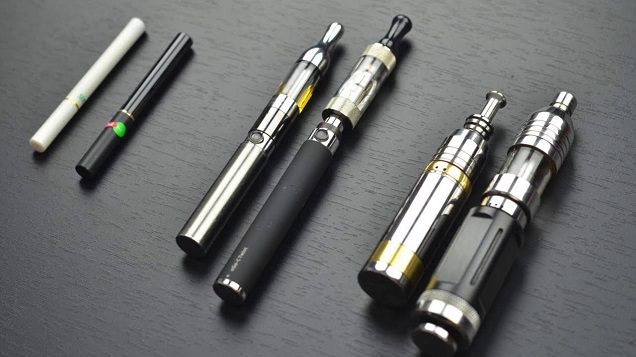
The atomizer is what turns your e-juice into delicious, inhalable vapor, but like everything else when it comes to vaping, there are tons of options on the market, and to a beginner, it can seem very overwhelming. Should you get a sub-ohm tank or a basic clearomizer? What are RBAs, RTAs and RDAs? Does it really make a difference what atomizer you use?
For the next post in our Basics of Vaping series, we’re taking a look at the various types of vape atomizers on the market, along with their pros and cons.
Atomizer Basics
Although we covered this in a bit more detail in our “What are e-cigarettes and how do they work?” post, e-cig atomizers are really the key component of an e-cigarette. They’re basically composed of a heating coil, a wick and a reservoir for your e-liquid. When the reservoir – the “tank” – is full of e-liquid, it soaks into the wick, which feeds it through the center of your coil (or around the outside of it, depending on design). The coil gets hot when you press the “fire” button on your e-cig, and that turns the e-liquid into vapor.
No matter how advanced an atomizer you pick up, at their core, this is what they all do. There may be differences in how they hold e-liquid (or whether they do at all), how you install a new coil and many other details, but the basic formula is always the same.
Cartomizers
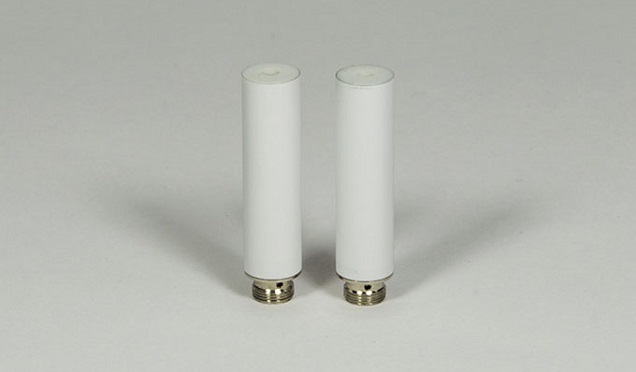
The most basic type of e-cig atomizer is the cartomizer. These were a big deal back in the early days of the industry because they combined the liquid reservoir with the coil, turning the once three-piece e-cigarettes into much more user-friendly two-piece varieties. This is the type of atomizer you still find on cigalike devices today.
Cartomizers look like cigarette butts: they’re cylindrical and screw into the battery portion of your e-cig (but only cigalikes), with a hole for inhalation in the tip. On the inside, they have a heating coil surrounded by wick material. There is a lot of wick material inside to allow the small containers to hold as much liquid as possible without leaking, but they still only hold about 1 ml of e-juice, and while it’s possible to re-fill them, they’re designed to be disposed of once the juice is used up.
If you want to refill one, you have to prize the tip off – this can usually be done with a pin or nail – and then soak the wadding surrounding the wick in e-liquid. Once you’ve filled, leave it to soak in for 20 minutes or so and you’ll be ready to vape.
Pros
- Very easy to use.
- Work with cigalikes.
Cons
- Normally poor vapor production.
- Flavor isn’t great.
- Expensive.
- Difficult to refill.
- Small juice capacity.
- Only work with cigalikes.
Clearomizers
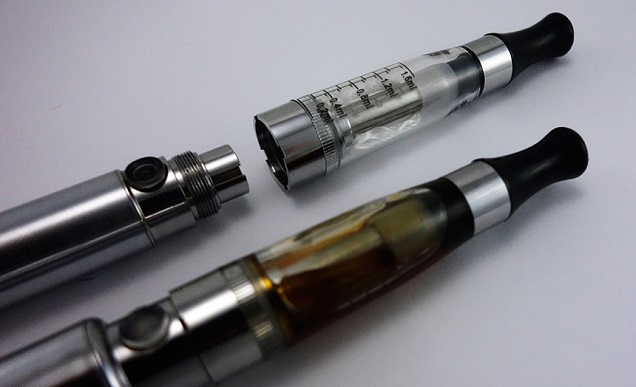
Clearomizers are just a step up from cartomizers – and were originally designed as a clear cartomizer, hence the name – but in terms of performance the difference is notable.
A clearomizer consists of a central tube that attaches to a wick-and-coil-containing atomizer head, with a small tank for your e-liquid surrounding it. This is a transparent tank, so you can see how much e-juice you have left, and they screw apart from the top or bottom, allowing you to easily refill with whatever e-juice you want.
While cartomizers surround the coil with wicking material, clearomizers usually have the wicks threaded through the center of the coil and protruding out into the tank section. This allows them to soak up liquid from the tank, which is drawn directly into the center of the coil to be vaporized. The atomizer heads are also replaceable, so when your coil is past its prime, you can replace it with a new one and continue using the same device. The replacement atomizer heads are still a running cost, but they save you a lot in comparison to cartomizer-based vaping.
Finally, clearomizers come in two layouts: top-coil and bottom coil. These mean just what it sounds like: top-coil device have the coil at the top of the central stem, and usually long wicks hanging down from it, and bottom-coil options move the atomizer head to the bottom of the stem, and only have a small amount of wick protruding from the atomizer head. While both can work well, bottom-coil options are superior because your e-juice doesn’t have to fight gravity to make its way up to the coil; gravity works on your side.
Clearomizers have eGo threading, which means they work on mid-sized e-cigarettes and some mods, but this is becoming less common on high-end devices.
Pros
- Easy to use.
- Refillable.
- Replaceable coils.
- Good vapor production.
- Good flavor for bottom-coil options.
- Work with eGo-style devices.
Cons
- Top-coil varieties struggle with wicking.
- Can’t tolerate high wattages.
- Not compatible with most mods unless you have an adapter.
- Reasonably small tanks – ordinarily around 1.6 ml.
- Ordinarily plastic tanks – strong citrusy liquids may crack them.
Tanks and Sub Ohm Tanks
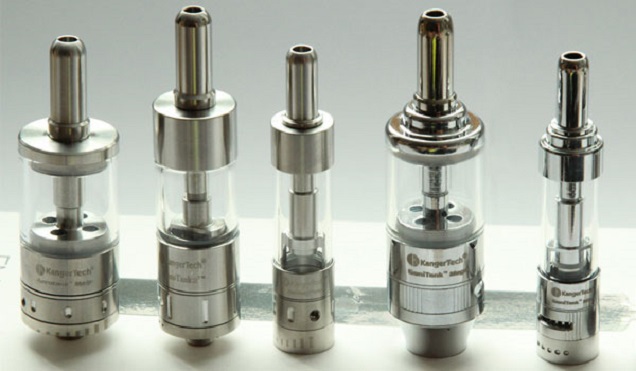
A tank is basically a big clearomizer. While the liquid reservoirs in vape tanks tend to be around 1.6 ml or a little larger, tanks use the same basic design with much larger capacities, so you don’t need to fill up as often as you would with clearomizer. Depending on the tank, this could be anything from 2 ml right up to 5 ml or even more. The coil is still replaceable in the same way, and the majority of vape tanks use a bottom-coil design.
Aside from the ability to hold more e-liquid, vape tanks are often made of glass instead of plastic. This means they can stand up to strong citrusy or cinnamon-based liquids that would risk cracking a plastic tank. They also have 510 connections, which is the standard connection for mods, and can also work with eGo-style connections, just without using the threading on the outside of the contact point. This can look a bit odd without something to cover the outer threading (called a “beauty ring”), but it will work in any case.
Most vape tanks also allow control over the airflow to your coils. This can make a difference between a tight draw (like a cigarette) and a loose, airy draw (which improves vapor production at the expense of flavor). Finding the right airflow setting for your preferences isn’t always easy, but having the option gives you yet another option for tailoring your experience.

Sub ohm tanks are basically the same as standard tanks, but their coils have lower resistance, specifically lower than one ohm. This means they can cope with higher wattages and will generally boost flavor and vapor production. The atomizer heads connect to the devices in the same way as clearomizers and other tanks, but they generally have larger wicking ports so that the juice supply can keep up with the speed it’s being vaporized at. Sub ohm tanks can usually cope with higher-VG liquids, too.
The downside to sub ohm tanks is that they require more capable devices – usually higher-power mods – to run safely. The reason for this, without getting into the details, is that a given battery can only supply so much current, and lower-resistance coils will draw more current than higher-resistance ones at the same voltage. E-cigarettes generally set a minimum resistance and a maximum current to keep you safe. Newer mods are basically all capable of working with sub ohm tanks, but you’ll need to check the minimum supported resistance to be sure.
Sub ohm tanks often also work with temperature control coils. These are made from nickel, stainless steel or titanium and can be used alongside temperature control mods to provide a more consistent performance and avoid unpleasant “dry hits.” We’ll cover temperature control in more detail in a future post, but for now keep in mind that you’ll probably need a sub ohm tank to make use of temperature control.
Overall, tanks and sub ohm tanks are both really just more efficient clearomizers, but this should have given you some insight into why they’re often seen as distinct devices.
Pros
- Easy to use.
- Refillable.
- Replaceable coils.
- Fantastic vapor production (especially sub-ohm tanks).
- Great flavor.
- 510 connections compatible with most non-cigalike devices.
- Glass tanks with large capacities – 2 to 5 ml of juice (or more).
- Work at higher wattages (especially sub ohm tanks).
- Adjustable airflow.
- Temperature control compatible.
Cons
- Sub ohm tanks require a high power mod to run.
- Higher start-up cost than clearomizers, but still affordable.
Rebuilable Atomizers (RBAs)
An RBA is a rebuildable atomizer. The key difference between these and other types of atomizer is that rather than screwing pre-built coils into place, you actually wrap your own coil and insert the wick yourself. It’s like a do-it-yourself atomizer head. This might sound like a lot of unnecessary work, but the big benefits of rebuilding are the performance – which is still hard to beat in terms of flavor and vapor production – and minimizing the cost of new coils. They also all use 510 connections, so are compatible with most devices on the market.
There are two main types of RBA on the market, rebuildable dripping atomizers (RDAs) and rebuildable tank atomizers (RTAs), which we’ll look at in turn:
Rebuildable Dripping Atomizers (RDAs)
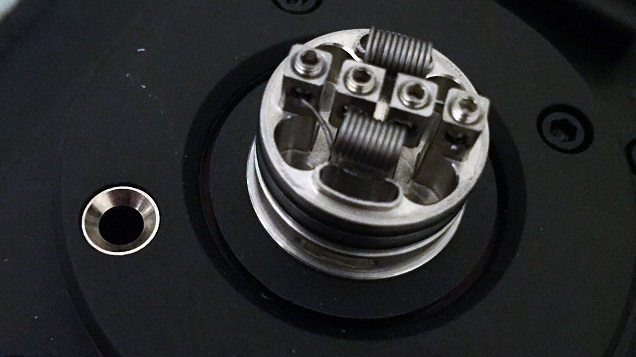
RDAs strip the core elements of an atomizer down to their most basic form, basically forgetting about the liquid reservoir and focusing on the coil and wick. A very basic RDA would simply consist of a deck with two posts sticking up out of it, covered over with a “top cap” which also contains the mouthpiece you inhale through.
You wrap a coil using Kanthal wire (or nichrome, nickel, titanium or stainless steel) and attach either end to the two posts. In some cases, this means trapping the ends of the wire under the heads of the screws in the posts, but more often there are holes in the center of the posts which you just thread the wire through and trap in place by tightening the screws. Then, you insert a wick through the center of the coil or wrap some wicking material around it.
The only question left is “where does the e-juice go?” The answer is that you just drip it directly onto the coil. This will soak the wick and allow you to vape for a little while, and when it starts to dry out you just add more liquid. RDAs have a “juice well,” which is basically a raised lip around the deck that allows you to have a small amount of juice pooled up in the bottom in order to minimize how often you have to drip.
So while it isn’t exactly complicated (especially if you’re happy to do some tinkering), it is clearly more complicated than using pre-built coils and a tank. This is why rebuildable devices are generally only recommended for people who’ve been vaping for a little while – when you’re making the switch from smoking, you hardly want to be spending your time making coils and getting to grips with an RDA. You’ll also need a device that can check the resistance of your coil, and that has some basic safety features, so VV/VW mods are ideal. Again, RDAs are well-suited to long-term vapers, but less so to those now to the hobby.
Pros
- Wick and wire is very cheap, much, much more so than pre-built coils.
- Generally affordable devices, though this does vary.
- Excellent performance, for both flavor and vapor.
- Well suited to high-wattage vaping.
- Allows you to tailor your vaping experience to suit your preferences.
- Almost all have adjustable airflow.
- 510 connection for wide compatibility.
- Easy to change your flavor.
Cons
- Much more complicated than pre-built coils – not for beginners!
- Leaking is often an issue through the airholes.
- Possible to use with an eGo-style device, but not recommended.
- Some knowledge of battery safety and ohm’s law recommended.
Rebuildable Tank Atomizers (RTAs)

After learning the basics of RDAs, there are a couple of different ways you can think about rebuildable tank atomizers (RTAs). One very natural way to think about them is like an RDA surrounded by a tank. This captures how they’re laid out: at the center of the tank, there is a small chamber, and inside you basically have a smaller version of an RDA’s deck, and you connect your coils in exactly the same way.
The other way to think about them is like other tanks except with a “DIY” atomizer head. This is particularly the case on devices like the Kanger Subtank, where you have compatible pre-built coils and an RBA head, which turns the device into an RTA.
This also captures one final aspect of how RTAs work: just like on tanks, you leave a small amount of wick protruding out into the main tank section so it can be replenished with liquid. There are small differences – around the bottom of the chamber, there are channels cut into the deck so juice can be drawn up towards your wick and coil – but this gives you the general idea.
The core reason you’d opt for an RTA would be to get rebuildable-like performance with the convenience of a tank system. Sub ohm tanks do compete with them in this sense, but you’ll save money vaping with an RTA, and you’ll also have more control over your experience.
Pros
- Affordable – both the devices and the wick and wire.
- Top-notch performance in terms of flavor and vapor.
- Adjustable airflow is pretty much a given.
- More convenient than RDAs – no need to drip!
- Tailor your vaping experience to suit your needs.
- 510 connections.
Cons
- Not for beginners.
- Not as well-suited to changing flavors as RDAs.
- A mod is recommended.
- Knowledge of battery safety an ohm’s law is recommended.
Conclusion – Choosing Your Atomizer
So there is quite a lot of variety in vape atomizers, but thankfully they all share the same key features. Choosing which type of device is best for your needs isn’t always easy, but as a general rule, for a new vaper it’s hard to beat a tank system, sub-ohm or not: they’re easy to use and offer great performance, and some are well-suited to beginner-friendly devices. For long-term vapers looking for the best performance, sub ohm tanks and rebuildables are hard to beat.

